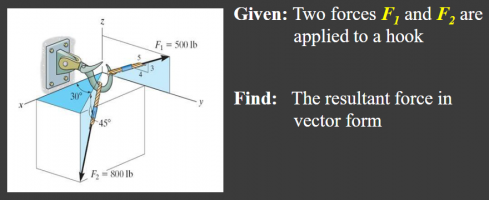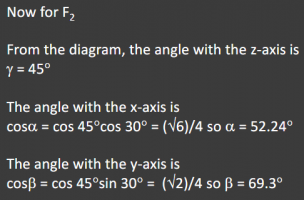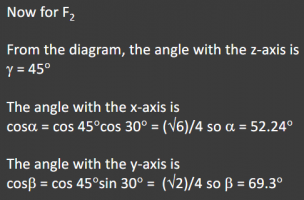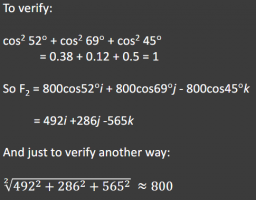isquaredplusone
New member
- Joined
- Jun 23, 2022
- Messages
- 7
Hello,
apologies if my description is a bit hard to follow - I'm not very familiar with this and I may not use the correct terminology.
I am trying to find the direction cosine alpha of a 3d vector, where I know the angles that vector describes on the x-y plane (30 degrees) and against the z-axis (i.e. direction angle gamma) (45 degrees).
I have a solution for cos(alpha) as follows:
Cos(alpha) = cos(45).cos(30) = 52.24 degrees
However, I don't understand why this equation gives the correct answer. I can see that the cos(45) is effectively bringing the vector up onto the x-y plane and the cos(30) is then bring it across to the x-axis, but why does their product then yield alpha?
Similarly, the direction cosine beta is given as:
Cos(beta) = cos(45).sin(30) = 69.3 degrees
Again, I can see how these two triangles relate the vector to the y-axis, but I don't understand why the product gives beta.

Apologies if my description is unintelligible, but any help would be greatly appreciated,
Thanks

apologies if my description is a bit hard to follow - I'm not very familiar with this and I may not use the correct terminology.
I am trying to find the direction cosine alpha of a 3d vector, where I know the angles that vector describes on the x-y plane (30 degrees) and against the z-axis (i.e. direction angle gamma) (45 degrees).
I have a solution for cos(alpha) as follows:
Cos(alpha) = cos(45).cos(30) = 52.24 degrees
However, I don't understand why this equation gives the correct answer. I can see that the cos(45) is effectively bringing the vector up onto the x-y plane and the cos(30) is then bring it across to the x-axis, but why does their product then yield alpha?
Similarly, the direction cosine beta is given as:
Cos(beta) = cos(45).sin(30) = 69.3 degrees
Again, I can see how these two triangles relate the vector to the y-axis, but I don't understand why the product gives beta.

Apologies if my description is unintelligible, but any help would be greatly appreciated,
Thanks
Last edited:



